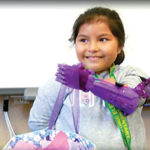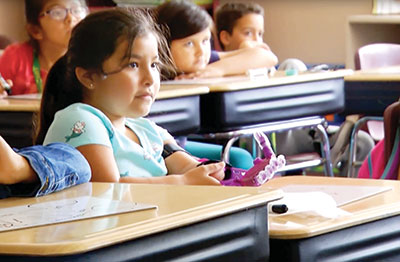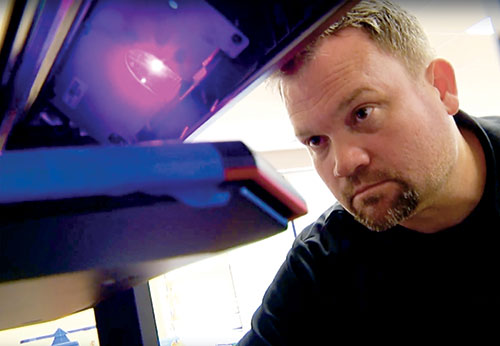
Elementary-school teacher gives student a one-of-a-kind gift
Caution: the mouthwatering aroma of waffles cooking is not, perhaps, everything it seems to be. Rather, you just might be catching a whiff of a 3-D printer churning out its latest coded creation.
Eric Demeri (’04, Elementary Education), former science enrichment teacher at Sunshine Elementary School in Lehigh Acres, says, “Everyone agrees – 3-D printing smells a lot like waffles.” It is, therefore, safe to say, that as the founder of the 3-D Printing Club at Sunshine, Demeri has whiffed a lot of waffles.

It all started with an anonymous donor whose only stipulation for spending the funds was 1) that whatever was purchased was available for use by all students, and 2) the use had to be science related. Demeri suggested the purchase of 3-D printers. “Technology is big in students’ lives, and 3-D printing is the way of the future,” he says. “What better time to introduce students to this relatively new technology than in elementary school?”
The idea was met with immediate enthusiasm. Three small student printers and one larger “teacher” printer were purchased, although the teacher printer is available for use by students with larger projects.
Demeri first assigned students the task of making themselves pencil holders for their desks. Students then brainstormed making something for their teachers and decided on marker holders. Next, they talked about making things for other students, and the club progressed from there.
And that’s what got Demeri thinking. He had a student, then-third-grader Dulce James, who he had known since she was in kindergarten. She had been born without her left arm from just below the elbow. “I wondered if I could do something to help her. I didn’t know how I’d go about it. Could I print a prosthetic? I got in touch with her mother who agreed it was certainly worth a try. Dulce, too, was excited with the prospect.”
Not knowing anything about printing a prosthetic arm, Demeri researched online and discovered just the company he needed. “E-nable is a non-profit company that writes computer programming for lots of different things, arms being one,” he says. “It’s an open-source software and, once downloaded, anyone can manipulate the coding to fit their needs.”

He wasted no time in downloading the coding and manipulated it to make it fit for Dulce. He spent nearly 40 hours – the bulk of his spring break – working on the project. “I started with the fingers, moved to palm, forearm, bicep. Each part required a different amount of time to code and print and a different technique,” he says. “3-D printers are slow. Very slow. The project required a lot of watching.”
Once all components were printed, Demeri pinned them together with, what else? – pins that had also been 3-D printed. Then he ran a strong wire up the inside of the fingers, on top of the palm and into the forearm, looping the wire around the elbow joint and attaching it to the 3-D printed adjustment box molded to the bicep. By bending her arm at her elbow, Dulce could control the prosthetic arm and fingers, pick up objects, wave!
It’s impossible to capture in words not only the thrill Dulce felt when she saw her arm for the first time, but also Demeri’s response to the moment. “It was emotional,” he says. “When she saw it, she was clearly excited. But when she turned to her mother and they hugged with tears in their eyes that was the point it really hit me.”
Although FGCU 360 Magazine was unable to reach Dulce or her mother, Ana Bustos, their reactions are clear in the video produced by the Lee County School Board on the day Demeri presented Dulce with her new arm. The video can be viewed on fgcu360.com.
The story, however, doesn’t end there. One week after receiving her arm, along with all the publicity that surrounded it, the Shriners contacted the family and offered to fit her with a fully functioning, medically manufactured prosthetic, free of charge.
[vc_video link=”https://youtu.be/ZuiOELrX3JQ” align=”center” padding=”0″”]Every story, of course, has a beginning. Demeri’s began in 1999, when he enrolled in FGCU, first as a biology major, transferring to elementary education in his junior year.
“FGCU was everything I hoped for,” he says. “In bigger schools, you’re just a number. At FGCU, the professors know your name. They’re very hands-on, especially in the College of Education. Very willing to help you, to go the extra mile to make sure everything you need done, gets done. I know I wouldn’t have found that in other schools.”
After graduation, Demeri secured a job at Spring Creek Elementary teaching third grade. From there, he joined faculty at Sunshine Elementary School, first teaching third grade for four years, later moving to teaching science enrichment with students from kindergarten to fifth grade, which was how he came to know Dulce.
In June, he relocated to Tennessee and immediately secured a job as a fourth-grade math and science teacher at Capshaw Elementary School in Cookeville.
He was so inspired and energized by his work with Dulce that he joined E-nable’s team of volunteers as a builder-volunteer. E-nable matches volunteers with people who contact the company asking to find someone willing to build a 3-D prosthetic either for themselves or a loved one. If they live within a 100-mile radius of Demeri, he just may receive the call.